NASA is involved in Earth-monitoring initiatives, notably those connected to climate change, in addition to space projects. It is currently developing a plan to employ drones to monitor active volcanoes and issue eruption alerts.
NASA is working with Black Swift Technologies, a business that makes very durable unmanned aircraft systems (UASs) that can endure the harsh circumstances found above volcanoes. In a statement, Florian Schwandner, director of NASA Ames' Earth Sciences division, said, "We needed it to be particularly tough, to resist flying in the turbulent circumstances and corrosive chemicals around volcanoes. We also created a gas-sensing payload that might be carried by the UAS to hunt for signals of volcanic instability."
In 2013, a first version of the UAS was used to monitor a volcano in Costa Rica, and more recently, a newer version of the craft was tested with flights at Makushin Volcano in Alaska's Aleutian Islands. By combining autonomous technologies with a pre-set flight path to reach the volcano's summit, the drone can fly even when it is out of sight range of the pilots. It can then capture visual and thermal data on volcanic activity from there.
“Our goal is to continue to push the capabilities of UASs to provide valuable insight into natural phenomena,” said Jack Elston, CEO of Black Swift Technologies. “This deployment demonstrated some state-of-the-art automation technologies we think will help greatly simplify what are now very difficult UAS operations. One of the most exciting results was to see our custom autopilot system determine when conditions had become too dangerous and turn back.”
The goal is to expand this technology to the point where it can monitor volcanoes on a regular basis and operate as an early-warning system if an eruption is about to occur.
“Working with NASA and Black Swift, our scientists believe we can use UASs to help authorities warn communities about the onset of dangerous volcanic eruptions, and many other hazards that now take us by surprise,” said Jonathan Stock, director of the United States Geological Survey National Innovation Center. “With this tool, we could routinely monitor even remote volcanoes for activity and respond to eruption events — a gamechanger for the safety of both our scientists and the communities around these geologic hazards.”



